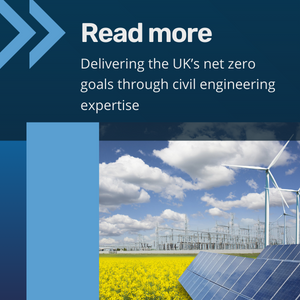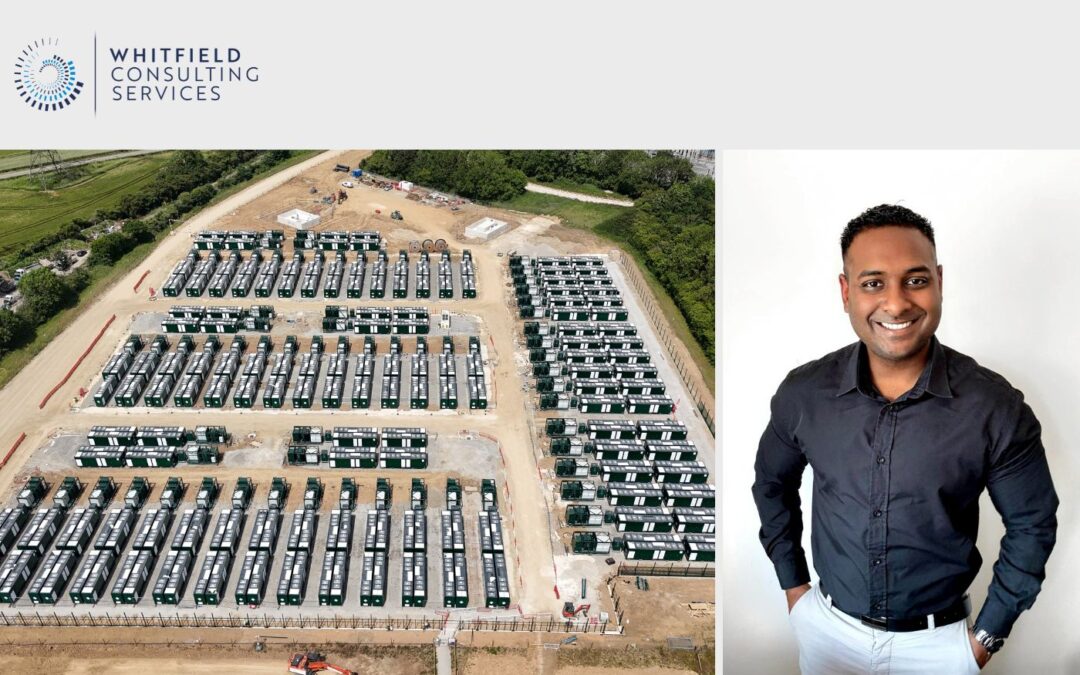In a small village in North Yorkshire, a major piece of the UK’s energy future is taking shape. Monk Fryston, a 320MW Battery Energy Storage System (BESS), is SSE Renewables’ largest battery project to date. Designed to power over half a million homes for up to two hours, the project is playing a key role in the UK’s renewable energy transition by helping to balance supply and demand on the grid, improving overall grid stability.
Behind the high-voltage infrastructure and containerised battery systems sits a series of carefully considered civil engineering decisions – each one necessary to ensure delivery, safety, and long-term function.
Whitfield Consulting Services (WCS) was appointed by M Group to deliver the civil and structural engineering design across both the main BESS compound and the National Grid bay connections. The scope covers site layouts, earthworks, drainage and firewater containment, substructure design, cable routing and containment, fencing, access roads, temporary works designs, and ongoing construction-phase support. All of which are essential components of the civil engineering design required to ensure equipment operates as intended throughout the system’s life cycle.
Meeting the demands of large-scale BESS design
“The Monk Fryston site presented a number of technical and delivery challenges,” says Shane Govender, Principal Civil Engineer at WCS. These included tight deadlines, space constraints, third-party electrical design, challenging site topography, and firewater and stormwater containment.
“These challenges are typical of large-scale Battery Energy Storage System schemes, where the civil design must support construction, operation, and regulatory requirements from the outset,” says Shane.
Challenge one: tight deadlines
The design process had to be accelerated to meet construction programme milestones and start dates.
“To meet the tight construction deadlines, we adopted a fast-track design approach, prioritising critical-path elements and early contractor input,” says Shane. This approach enabled critical construction activities to proceed on schedule, mitigating programme delays.
Speed was further built into the programme through the use of modular and prefabricated components, particularly for control buildings and equipment bunds, to reduce on-site construction time.
Challenge two: space constraints
A limited site footprint left minimal room for material storage and restricted flexibility for construction phasing.
To address the site’s limited footprint, WCS developed compact structural solutions. These included supporting the installation of modular buildings, reducing foundation footprints through deeper embedments, and utilising below ground water tank installations. The team also streamlined construction sequencing by expediting certain design elements, enabling concurrent activities and maximising available space during phased construction. These measures collectively eased on-site congestion and maintained project momentum.
Challenge three: challenging topography
The project faced significant challenges related to complex earthworks requirements.
The proposed stepped terrace design would have led to significant bulk earthworks, drainage, and constructability issues that WCS were able to simplify through 3D design.
“We reassessed the existing cut-and-fill strategy using 3D terrain modelling to optimise a balanced cut and fill for the earthworks,” says Shane.
“Our revised approach minimised material export and improved the drainage strategy and constructability, resulting in a more practical and cost-effective site development plan,” adds Shane.
Challenge four: split design responsibilities
With a separate consultant leading the electrical design, close coordination was essential to avoid interface conflicts.
“Given the split design responsibilities across civil and electrical disciplines, we implemented a robust interdisciplinary coordination process,” says Shane.
Regular workshops and a design responsibility matrix were used to ensure all interface conditions, particularly around drainage, ducting, equipment plinths, and structural clearances, were fully addressed at the design stage.
“Effective integration between civil and electrical teams reduced interface clashes, supporting smoother design and construction workflows, mitigating rework,” says Shane. “By achieving clarity of roles and responsibilities early, we were able to build a robust, well-coordinated design process from the outset.”
Challenge five: firewater and stormwater containment
The site required retention/detention systems to accommodate both the firewater deluge and stormwater capacities, whilst maintaining environmental standards.
WCS’s approach of early-stage hydrological and hydraulic modelling optimised containment systems and oil/debris separators ensured regulatory compliance and environmental safety without compromising space or constructability.
Challenge six: sustainability and carbon reduction
Traditional civil engineering methods would have required high volumes of imported aggregates and concrete, raising carbon emissions and programme durations.
“At WCS, we always seek to incorporate value engineering and sustainable solutions wherever possible,” says Shane. “In this project, we incorporated soil stabilisation techniques – such as Sureground reversible cementitious binder for platforms and internal roads, with armoured Cement Bound Granular Mixture (CBGM) surfacing for internal roads – in our design to help reduce the carbon footprint by reusing in-situ materials, which meant less haulage and faster delivery. This approach also improved ground strength, allowing for smaller foundations and reducing the amount of concrete required,” says Shane.
Another addition was the replacement of traditional concrete foundations with screw piles, further lowering the carbon footprint and shortening the construction programme. “WCS was involved throughout the design and build process, including conducting a detailed design review of the supplier’s proposal to ensure it met UK standards for performance and sustainability,” adds Shane.
Power & Energy experience
While Monk Fryston stands as one of the UK’s largest Battery Energy Storage System projects, the design principles and approach developed here are widely applicable across the broader Power & Energy sector. Early risk mitigation, practical sequencing, and clear interface management are key to achieving both compliance and delivery efficiency.
“Whether delivering a BESS site or a substation for a new offshore wind farm development, WCS consistently applies its core values of agility, collaboration, and industry experience,” says Shane. “Our team brings the practical, hands-on experience to support construction teams on the ground, as well as the technical design capability,” adds Shane.
WCS is proud to support the projects that are powering the UK and Ireland’s transition to renewable energy:
- See our downloadable case study brochure for the Power & Energy sector, detailing projects including Dogger Bank, the world’s biggest offshore wind farm.
- Read part one and part two of our recent projects won series, including our work on Hornsea 3 and London Power Tunnels 2.
- Read our article to learn more about the role civil engineers are playing in making BESS projects viable.
The WCS approach
“WCS’s civil engineering approach is rooted in early and active involvement,” says Shane. “Failure to address any aspects early in a project can result in major risks: project delays, safety issues, unnecessary costs, and misalignment between civil and electrical works.”
“We prioritise identifying risks early and keeping clear communication with all disciplines,” adds Shane. “It’s about agility in design and continuous collaboration.”
Once complete, Monk Fryston will be one of the UK’s largest operational battery energy storage sites. Civil engineering has shaped how the site is being built, how it will perform, and how it can be decommissioned responsibly decades from now.
From feasibility through to end-of-life planning, our civil engineering design supports delivery and the long-term success of the UK and Ireland’s net zero goals.
To find out more about our Power & Energy experience, click here. Or, if you would like to discuss your next project, please get in touch by emailing info@wcs-consult.co.uk or calling +44(0)20 3581 7847.

